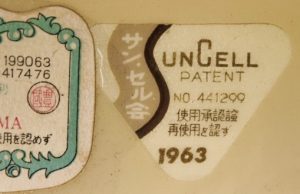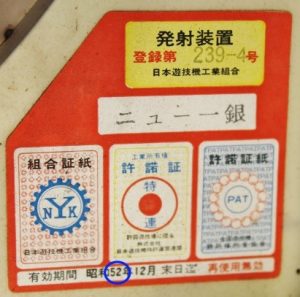Determining the exact year of manufacture of a pachinko machine can be a difficult. The first thing to understand is that unlike automobiles in the US, there were no real "model years" for pachinko machines. When a machine was ready for production, they produced it, and continued to produce them until sales declined to a level where they were no longer worth producing. A particular model might be initially produced in 1973, but still see limited continued production for several years after if it is popular. Collectors are not generally concerned with the particular year a machine was made, but rather tend to consider all of the same model as being from the first year of production. Manufacturers might introduce several different models in a single year, with only one of them continuing to be produced in the next. So the challenge is to try to determine the first year of production for a particular machine model. Below are a few methods that can help you.
Expiration tags
The first method most people use is to examine what are commonly called the expiration tags. These tags or stickers will be affixed to the playfield, either by glue, a small nail, or a staple. These are actually certification stamps that the Japanese Gaming Authority would affix when they were installed in parlors. They have been called expiration tags for decades by hobbyists, so we will retain that somewhat inaccurate nomenclature. The date on the sticker is typically one year later than the date of manufacture, because that was the period when the majority of a particular model was sold and certified.
Many pachinkos have lost the tags, and some types do not display a date. A good number of 1950's and 1960's machines had small triangular stickers that clearly indicated the patent date in western characters such as 1964. These tags are typically referred to as patent tags, and should not be confused with expiration tags. These antique pachinko machines would normally have an expiration tag as well.

Patent 1963
Later rectangular and circular tags show the year the machine was certified by using the Shōwa year. You may find the numbers 49 and 6 in small font on a sticker for example. The 49 is not 1949, but the Shōwa year 49. The conversion is simple. Add 1925 to the number. In this case, 1925 + 49 = 1974, so the tag indicates 1974. That means the machine was likely manufactured in 1973 because 1974 is when it was to be removed from the parlor.
Example tags:

Shōwa 29. Manufactured 1953

Shōwa 50. Manufactured 1974

Shōwa 51. Manufactured 1975

Shōwa 52. Manufactured 1976

Shōwa 54. Manufactured 1978
Examine the features
A second method is to look at the features of the pachinko machine and compare it to the information found in 'History of pachinko' section of this website. For example, if the machine has tulip-style ball catchers, it was probably produced in 1960 or later.
Compare with other pachinko machines
A third method would be compare to pictures of pachinkos with known manufacture dates. This can sometimes be difficult as so many manufacturers produced so many different models, but sometimes it can get you the information you need. Check the 'models' section of this website and maybe you will get lucky!
Ask around
Lastly, if all else fails, ask around! Post up some pictures on the pachitalk forum, and hopefully someone there can help you identify your tough-to-date pachinko machine!
